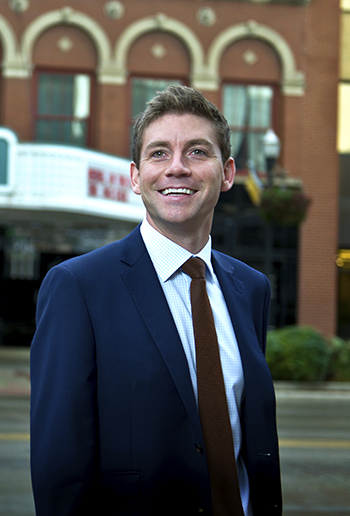Placing a priority on client education
Placing a priority on client education

Matthew Rubis • Fargo, ND
Rubis Financial, Inc. • Parkland Securities, LLC
Read full biography below
Proactive Advisor Magazine: Matthew, what was your path into the financial-services industry?
My father has been in the industry for just over four decades, starting right after he graduated college. He has primarily been focused on the insurance side of the business and has had a very successful career, not just with his own clients but in running agencies in our tri-state area and supervising many agents.
I was always around his business growing up and joke with clients that I knew the difference between a Roth IRA and a traditional IRA when I was in junior high. It was instilled in me at a young age that having insurance coverage was a very important part of a family’s financial plan. That is something I still believe today. I view insurance as an important element of overall risk management for our clients.
I graduated from the University of Colorado with a degree in finance and had to make the decision if I would join my father’s business in North Dakota or pursue an offer I had from a top-tier financial advisory firm in Colorado Springs. I decided that working alongside my father would be an excellent opportunity to expand his practice’s offerings, taking the practice more into the area of comprehensive financial advising. He had a strong client base that we believed would be open to holistic financial planning and investment management. We stressed to clients that we were a family business and conducted many joint meetings for the first couple of years. This has turned out to be a successful strategy, and our firm has continued to grow.
How do you approach the planning process with clients?
 When I’m sitting down with people, I realize that financial planning and finances can be an overwhelming topic. For most people, it seems very complicated, and this can cause anxiety for people or even discord between family members, spouses, or business partners. To that end, I see my primary role as a financial advisor as helping to first educate people and then guide them toward financial decisions that can impact their lives in a positive way.
When I’m sitting down with people, I realize that financial planning and finances can be an overwhelming topic. For most people, it seems very complicated, and this can cause anxiety for people or even discord between family members, spouses, or business partners. To that end, I see my primary role as a financial advisor as helping to first educate people and then guide them toward financial decisions that can impact their lives in a positive way.
We try to look at all areas of our clients’ financial pictures. Coming from the background of starting in an insurance office, I realize that there are a lot of additional aspects that need to be examined when working with clients. The financial plan involves all of the major financial elements that individuals or families really should be addressing, including insurance planning, investment planning, retirement-income planning, estate and legacy planning, household budgeting, tax strategies, college planning, and health-care planning. If we do not have the experience in-house for a specific client need, or if their needs are very complex, we have access to some highly qualified outside resources that we can refer to or work jointly with.
Our process starts with exhaustive discovery, covering the financial attitudes and underpinnings of clients’ lives, such as current net worth, assets, liabilities, income, current portfolio allocations, insurance coverages, and so forth. We use a comprehensive software system to help collect and organize that data, which also helps us go through a sequential financial-planning process and get to actionable recommendations. We discuss future goals in great detail, time lines, risk tolerances, and the unique circumstances that every family has. At the core, as a financial advisor, my job is to pick apart these factors, educate clients about various potential planning scenarios, and come to an agreement on forward-looking action plans.
Talk about your approach to risk management, especially for client investment portfolios.
We focus on risk management in everything we do for clients. This is pervasive throughout the planning process, starting with our deep experience in the insurance area but going beyond that to all elements of the financial plan. We examine both the macro or environmental risks that could affect a client’s financial situation, as well as those that might be specific to their family or business circumstances.
For investment management, this usually starts with an evaluation of what they have been doing with their portfolios before coming to work with us. Usually, they’ve been using some basic asset-allocation methodology. As we examine what they have been doing in the past, it often becomes apparent that they do not realize the level of risk in their portfolio or whether it is a suitable level of risk. We do a lot of education on that topic and take clients through a qualitative and quantitative risk assessment specific to their needs and objectives.
From there, we give clients a high-level overview of the sophisticated investment strategies that our firm has available through third-party investment managers. These managers primarily focus on risk management and downside mitigation. Once we get into the actual development of investment recommendations, we closely review the investment policy statement (IPS), which will outline goals and objectives.
As we review the IPS with a client, we will have a thorough discussion around the level of risk we think is appropriate for their portfolio and set proper expectations for what they can expect the portfolio to look like. While there are no guarantees on performance, we generally will recommend some use of active, tactical strategies that are highly diversified; seek to lower portfolio volatility; can respond to changes in market conditions; and have a great deal of flexibility in asset classes, sectors, and market exposure.
“We focus on risk management in everything we do for clients.”
Especially with clients nearing retirement, we are going to be more concerned with risk management than return. One might give up some of the upside of investing in the S&P 500 with tactical, risk-managed strategies, but we think the probabilities favor not experiencing near the level of drawdown that the S&P 500 can see in down markets. But I say that carefully, because over the long term, by helping to decrease volatility, managed strategies can perform very competitively with passive strategies—but with less risk exposure.
Living in North Dakota, I sometimes use the weather as an analogy for clients as they think about their investments. We have huge swings in weather conditions from summer to winter and can have major differences in conditions month to month or week to week. The way you dress, or prepare your home, or handle driving conditions has to be adaptable to changing conditions. Doesn’t it make sense that an investment portfolio facing changing market and economic conditions should similarly employ strategies that can adapt? There will be periods when strategies should be more aggressively positioned to take advantage of bullish market trends, and periods when playing defense makes sense. That is how we recommend in a broad sense that clients think about our approach to investment management.
As you further build your practice, what are some guiding principles that you think are important to communicate to clients?
I think there are several important messages that we deliver to prospects and clients that help to differentiate our firm and provide a good sense of how we would like to serve clients. First, as I mentioned earlier, this is a family practice with a long history. We are taking the tradition of excellent service my father has employed for over 40 years with his insurance clients and applying that to an expanded advisory practice.

Second, we put great emphasis on client education. My goal during any client meeting or an interview with a prospect is that I want them to walk away from that meeting knowing more about their financial situation and potential for improvement than they knew before. Related to this, I want clients to feel like we are sitting on the same side of the table. As they succeed in working toward fulfilling their financial objectives, our firm also succeeds.
Third, that we place risk management at the forefront of everything we do. This is especially true for investment management, where the current environment will not remain in place forever. There are many issues today that could have a huge impact on client portfolios, and we want to build a strategic allocation that can work over full market cycles and through changing market conditions. As part of this, we present highly diversified portfolio recommendations, which may include some alternative investments that have relatively lower correlations with the overall equity market.
Finally, our planning process is not a static one-time event. Life throws everyone curve balls, and things will happen—hopefully, the good will outweigh the bad. Our approach to financial planning involves continuously monitoring a client’s situation and potentially making adjustments through the years. We want our clients to keep their goals at the forefront and have a plan that can adapt—so they can continually work toward long-term financial security.

Strategies to address the needs of small-business owners
Small-business owners represent a multi-dimensional target audience for an advisory practice. Their needs include essential financial services for their business, as well as individual financial planning for themselves and key employees. Matthew Rubis employs several strategies in approaching this segment:
- Networking with property and casualty (P&C) insurance agents, attorneys, and accountants to identify mutually beneficial referrals.
- Offering a range of business services, including insurance planning (for example, key man and buy/sell agreements), business continuity planning, and guidance on employee and executive benefits.
- Providing services in several personal financial-planning areas, including retirement-income planning, legacy planning, risk management, and investment management.
- Recommending that business-owner clients review their company financial plans on a consistent schedule.
 Matthew Rubis is president of Rubis Financial, Inc., located in Fargo, North Dakota. Rubis Financial is a “full-service financial consulting firm dedicated to helping clients build wealth and manage their hard-earned assets,” says Mr. Rubis. His father, Tim Rubis, founded the firm in 2002 after several decades in the insurance industry and remains active in management and client service.
Matthew Rubis is president of Rubis Financial, Inc., located in Fargo, North Dakota. Rubis Financial is a “full-service financial consulting firm dedicated to helping clients build wealth and manage their hard-earned assets,” says Mr. Rubis. His father, Tim Rubis, founded the firm in 2002 after several decades in the insurance industry and remains active in management and client service.
Mr. Rubis was born and raised in the Fargo area and says he knew at a relatively early age that he was attracted to the financial-services industry. He graduated summa cum laude from the University of Colorado at Colorado Springs with a degree in finance and a minor concentration in accounting.
He joined Rubis Financial in 2010 with a goal of helping to expand the firm’s advisory services for clients. The firm offers guidance in the areas of retirement planning, tax strategies, estate planning, risk management, and investment planning and management. Mr. Rubis is also knowledgeable in the areas of employee and executive benefits, business continuity planning, and real estate tax strategies. He is a state board member of the National Association of Insurance and Financial Advisors (NAIFA) and was recognized as a “NAIFA rising star” in 2016. He is currently studying for the Accredited Investment Fiduciary (AIF) designation.
Mr. Rubis and his wife reside in Fargo and have a young daughter. He is an accomplished golfer and enjoys “spending quality time at home and at the lake with family.”
Disclosure: Matthew Rubis offers securities offered through Parkland Securities, LLC. Member FINRA/SIPC. Investment advisory services offered through SPC, a registered investment advisor. Diversification does not guarantee against a loss or ensure a profit, it is a method used to help manage risk. It is not possible to invest directly into an index. 1131 Westrac Dr., Ste. 204, Fargo, ND 58103. Ph: 701-232-7282.
Photography by Dan Koeck

